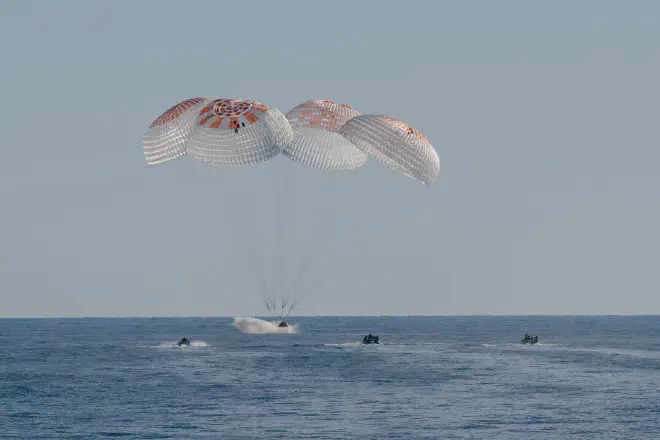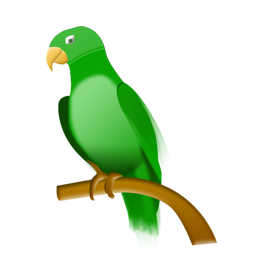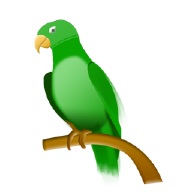

NASA astronauts Nick Hague, Suni Williams, and Butch Wilmore, and Roscosmos cosmonaut Aleksandr Gorbunov, returned to Earth at 5:57 p.m. EDT. Teams aboard SpaceX recovery vessels retrieved the spacecraft and its crew. After returning to shore, the crew flew to NASA’s Johnson Space Center in Houston and reunited with their families.
Hague and Gorbunov lifted off at 1:17 p.m. Sept. 28, 2024, on a SpaceX Falcon 9 rocket from Space Launch Complex 40 at Cape Canaveral Space Force Station in Florida. A day after, they docked to the forward-facing port of the station’s Harmony module. Williams and Wilmore launched aboard Boeing’s Starliner spacecraft and United Launch Alliance Atlas V rocket on June 5, 2024, from Space Launch Complex 41 as part of the agency’s Boeing Crew Flight Test. The duo arrived at the space station on June 6. In August, NASA announced the uncrewed return of Starliner to Earth and integrated Wilmore and Williams as part of the space station’s Expedition 71/72 for a return on Crew-9. The crew of four undocked at 1:05 a.m. Tuesday to begin the trip home.
Williams and Wilmore traveled 195,290,000 kilometers during their mission, spent 286 days in space, and completed 4.576 orbits around Earth. Hague and Gorbunov traveled 72,553,920 miles during their mission, spent 171 days in space, and completed 2,736 orbits around Earth. The Crew-9 mission was the first spaceflight for Gorbunov. Hague has logged 374 days in space over his two missions, Williams has logged 608 days in space over her three flights, and Wilmore has logged 464 days in space over his three flights.
Throughout its mission, Crew-9 contributed to a host of science and maintenance activities and technology demonstrations. Williams conducted two spacewalks, joined by Wilmore for one and Hague for another, removing a radio frequency group antenna assembly from the station’s truss, collecting samples from the station’s external surface for analysis, installing patches to cover damaged areas of light filters on an X-ray telescope, and more. Williams now holds the record for total spacewalking time by a female astronaut, with 62 hours and 6 minutes outside of station, and is fourth on the all-time spacewalk duration list.
The USA crew members conducted more than 150 unique scientific experiments and technology demonstrations between them, with over 900 hours of research. This research included investigations on plant growth and quality, as well as the potential of stem cell technology to address blood diseases, autoimmune disorders, and cancers. They also tested lighting systems to help astronauts maintain circadian rhythms, loaded the first wooden satellite for deployment, and took samples from the space station’s exterior to study whether microorganisms can survive in space.
The Crew-9 mission was the fourth flight of the Dragon spacecraft named Freedom. It also previously supported NASA’s SpaceX Crew-4, Axiom Mission 2, and Axiom Mission 3. The spacecraft returned to Florida for inspection and processing at SpaceX’s refurbishing facility at Cape Canaveral Space Force Station, where teams will inspect the Dragon, analyze data on its performance, and begin processing for its next flight.
The Crew-9 flight is part of NASA’s Commercial Crew Program, and its return to Earth follows on the heels of NASA’s SpaceX Crew-10 launch, which docked to the station on March 16, beginning another long-duration science expedition.
Crew-9 Science Mission’s Results #
Hague, Williams, and Wilmore completed more than 900 hours of research between more than 150 unique scientific experiments and technology demonstrations during their stay aboard the orbiting laboratory.
Mighty microalgae #
Nick Hague processed samples for Arthrospira C, an investigation from ESA (European Space Agency) that transplants and grows Arthrospiramicro-algae aboard the International Space Station. These organisms conduct photosynthesis and could be used to convert carbon dioxide exhaled by crew members into oxygen, helping maintain a safe atmosphere inside spacecraft. Arthrospira also could provide fresh food on long-duration space missions.
Improving astronaut exercise #
Researchers are testing the European Enhanced Exploration Exercise Device (E4D), a modular device that combines cycling, rowing, and resistance exercises to help keep crews healthy on long-duration missions. A single, small device effective at countering bone and muscle loss and improving cardiovascular health could help crew on future missions.
Garden watering #
A red romaine lettuce growing in the International Space Station’s Advanced Plant Habitat is part of Plant Habitat-07, a study of how different moisture levels affect the microbial communities in plants and water. Results could show how less-than-ideal conditions affect plant growth and help scientists design systems to produce safe and nutritious food for crew members on future space journeys.
Packing it in #
Packed bed reactors are systems that “pack” materials such as pellets or beads inside a structure to increase contact between any liquids and gasses flowing through it. Suni Williams installed hardware for the Packed Bed Reactor Experiment: Water Recovery Series (PBRE-WRS) investigation, which examines how gravity affects these systems aboard the International Space Station. Results could help scientists design better reactors for water recovery, thermal management, fuel cells, and other applications.
Fueling the flames #
During the Residence Time Driven Flame Spread (SOFIE-RTDFS) investigation at the International Space Station, a sheet of clear acrylic plastic burned at higher oxygen levels and half the standard pressure of Earth’s atmosphere. Studying the spread of flames in microgravity could help improve safety on future missions.
Monitoring microbes in space #
During his spacewalk, Butch Wilmore swabbed the exterior of the International Space Station for ISS External Microorganisms, an investigation exploring whether microorganisms leave the spacecraft through its vents and, if so, which ones survive. Humans carry microorganisms along with them wherever they go, and this investigation could help scientists take steps to limit microbial spread to places like the Moon and Mars.
A hearty workout #
Astronauts exercises on the International Space Station’s Advanced Resistive Exercise Device while wearing the Bio-Monitor vest and headband. The set of garments contains sensors that unobtrusively collect data such as heart rate, breathing rate, blood pressure, and temperature. The data supports studies on human health, including Vascular Aging, a CSA (Canadian Space Agency) investigation that monitors cardiovascular function in space.
On-demand medical devices #
Astronauts in the Station works with hardware for InSPA Auxilium Bioprinter, a study that tests 3D printing of an implantable medical device that could facilitate recovery from peripheral nerve damage, a type of injury that can cause sensory and motor issues. In microgravity, this manufacturing technique produces higher-quality devices that may perform better, benefitting crew members on future long-duration missions and patients back home.
Is wood better? #
A deployer attached to the International Space Station’s Kibo laboratory module launched LignoSat into space. Developed by JAXA (Japan Aerospace Exploration Agency), the satellite tests using wood as a more sustainable alternative to conventional satellite materials. Researchers previously exposed different woods to space and chose magnolia as the best option for the study, including sensors to evaluate the wood’s strain and its response to temperature and radiation. Researchers also are monitoring whether Earth’s geomagnetic field interferes with the satellite’s data transmission.
Making microbes in space #
Suni Williams worked with bacteria and yeast samples for Rhodium Biomanufacturing 03, part of an ongoing examination of microgravity’s effects on biomanufacturing engineered bacteria and yeast aboard the International Space Station. Microgravity causes changes in microbial cell growth, cell structure, and metabolic activity that can affect biomanufacturing processes. This investigation could clarify the extent of these effects and advance the use of microbes to make food, pharmaceuticals, and other products in space, reducing the cost of launching equipment and consumables from Earth surface.
A NICER spacewalk #
The International Space Station’s Neutron star Interior Composition Explorer, or NICER, studies neutron stars, the glowing cinders left behind when massive stars explode as supernovas. Hague installed patches during a spacewalk to repair damage to thermal shields that block out sunlight while allowing X-rays to pass through. The instrument continues to generate astrophysics discoveries reported in hundreds of scientific papers.
Earth from every angle #
From inside the International Space Station’s cupola, astronauts take photographs landmarks on Earth approximately 260 miles (418 kilometers) below. Crew members have taken millions of images of Earth from the space station for Crew Earth Observations, creating one of the longest-running records of how our planet changes over time. These images support a variety of research, including studies of phenomena such as flooding and fires, atmospheric processes affected by volcanic eruptions, urban growth, and land use.
Vital vitamins #
The BioNutrients investigation demonstrates technology to produce nutrients during long-duration space missions using engineered microbes like yeast. Food stored for long periods can lose vitamins and other nutrients, and this technology could provide a way to make supplements on demand.
Blowing in the solar wind #
The International Space Station’s robotic hand, Dextre, attached to the Canadarm2 robotic arm, moved hardware into position for the COronal Diagnostic EXperiment, or CODEX. This investigation examines solar wind and how it forms using a solar coronagraph, which blocks out bright light from the Sun to reveal details in its outer atmosphere or corona. Results could help scientists understand the heating and acceleration of the solar wind and provide insight into the source of the energy that generates it.
Can you hear me now? #
Roscosmos cosmonaut Aleksandr Gorbunov conducted a hearing test in the relative quiet of the International Space Station’s Quest airlock. Crew members often serve as test subjects for research on how spaceflight affects hearing and vision, the immune and cardiovascular systems, and other bodily functions. This research supports the development of ways to prevent or mitigate these effects.
Exposing materials to space #
Euro Material Ageing, an ESA investigation, studies how certain materials age when exposed to the harsh space environment. Findings could advance design for spacecraft and satellites, including improved thermal control, as well as the development of sensors for research and industrial applications. Suni Williams installed the experiment into the Nanoracks Bishop airlock for transport to the outside of the International Space Station.
Sending satellites into space #
Don Pettit and Butch Wilmore worked with a small satellite deployer from an airlock on the International Space Station. The deployer had released several CubeSats into Earth orbit including CySat-1, a remote sensor that measures soil moisture, and DORA, a receiver that could provide affordable and accurate communications among small spacecraft.
Robotic relocation #
The Responsive Engaging Arms for Captive Care and Handling demonstration (Astrobee REACCH) uses the International Space Station’s Astrobee robots to test technology for capturing objects of any geometry or material orbiting in space. This ability could enable satellite servicing and movement to maximize the lifespan of these tools and removal of space debris that could damage satellites providing services to the people of Earth. On his last mission, Suni Williams checked out an Astrobee fitted with tentacle-like arms and adhesive pads for the investigation.
Arms to hold #
As part of a program called High school students United with NASA to Create Hardware, or HUNCH, astronauts, as Nick Hague, for example, used the HUNCH Utility Bracket, a student-designed tool to hold and position cameras, tablets, and other equipment that astronauts use daily. Currently, crew members on the International Space Station use devices called Bogen Arms, which have experienced wear and tear and need to be replaced.
-
The article Welcome Home! NASA’s SpaceX Crew-9 Back on Earth After Science Mission, written by Jessica Taveau was published in NASA’s news section.
-
The article Ahead of Crew Return, NASA’s Crew-9 Concludes Science Mission, written by Melissa L. Gaskill, from International Space Station Research Communications Team was published in NASA’s website

